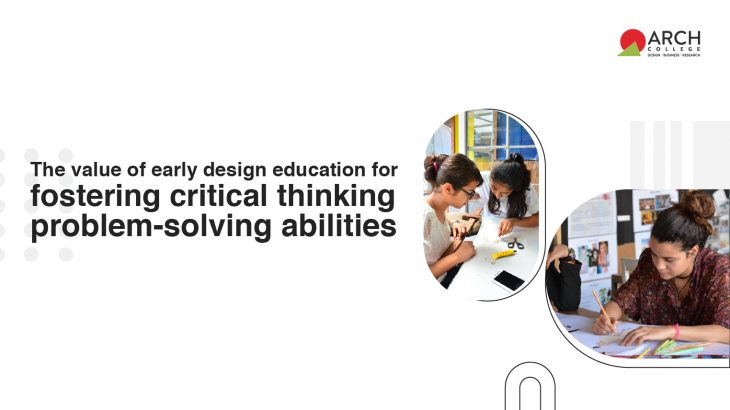‘Creativity is seeing what others see and thinking what no one else has thought.’ as quoted by Albert Einstein, creativity is not just an ability limited to a select few; it’s a skill that can be cultivated and nurtured in individuals of all ages. Its impact spans personal, professional, societal, and cultural spheres, contributing significantly to growth, innovation, and overall well-being. Encouraging and fostering critical thinking and problem-solving abilities, especially in children through early education, lays a strong foundation for a brighter and innovative future.
Connecting the dots between design education, critical thinking, and problem-solving skills
Creativity is a vital skill that goes beyond artistic expression; it involves thinking outside the box, finding innovative solutions, and adapting to new situations. In various aspects of life, from academics to professional settings, these abilities lay the groundwork for success, fostering resilience, creativity, and strategic thinking. These are essential skills for decision-making and continuous learning throughout life.
Design and problem-solving are intimately connected, providing a systematic method for tackling challenges. It involves identifying, understanding, and defining problems before brainstorming, creating, and testing potential solutions. Design thinking encourages iteration and adaptation based on feedback, allowing for more effective problem-solving by considering multiple perspectives and innovative approaches. Ultimately, design offers a structured framework that combines creativity, analysis, and user-focused solutions to address intricate challenges across various domains.
How Design Thinking Prepares Children for the Future?
Early design education incorporates elements of design thinking, arts, and hands-on activities to nurture young minds. This dynamic educational framework emphasizes exploration, experimentation, and real-time experiences, providing children with opportunities to engage in various design-related aspects. Design education at a young age encourages children to explore various materials, shapes, colors, and ideas. Whether it’s through drawing, building blocks, or crafts, these activities stimulate their imagination and allow them to express their ideas freely.
Teaching kids to approach challenges with a design-oriented mindset helps them reframe problems creatively. For instance, instead of seeing a limitation, they might perceive an opportunity for innovation.
By integrating design principles into early learning experiences, children gain confidence in expressing their ideas. This confidence not only applies to creative endeavors but also extends to problem-solving situations in various aspects of their lives. It cultivates ideation, iteration, empathy, and collaboration, preparing children for success in a rapidly evolving world where these abilities are highly valued.
The skills cultivated through early design education are transferable to numerous fields beyond traditional design. These skills are applicable in fields like science, technology, engineering, arts, and mathematics, preparing children for a wide range of future careers.
Early Design Education in Curriculum Policies
As of now, early design education might not be explicitly integrated into standard curriculum policies, but there’s a growing recognition of its significance. It’s increasingly evident that incorporating early design education into educational policies is crucial to equip students with essential skills for the future. The advent of India’s National Education Policy 2020 (NEP) has highlighted the crucial role of integrating art into the school curriculum, sparking widespread discussions on its importance in education.
The current educational landscape often prioritizes traditional subjects over creative and design-focused learning. However, acknowledging the rapidly changing global landscape, there’s a pressing need to introduce design principles early on. These principles encourage critical thinking, creativity, and problem-solving—indispensable skills in a world demanding innovation and adaptability.
Integrating early design education into curriculum policies would bridge the gap between theoretical knowledge and practical application. It would empower students to approach challenges creatively, fostering a mindset that values exploration, experimentation, and interdisciplinary thinking.
Design thinking empowers students to identify challenges, create inventive solutions, and take decisive action, nurturing the confidence needed to become tomorrow’s leaders and change makers.
Set Foot into Design Education – Your Journey Begins!
Are you someone who’s been drawn to creativity from a young age and now aspires to pursue a career in design, particularly in the captivating field of interior design? Are you tirelessly searching Google for interior design colleges near me, or top colleges for fashion designing, feeling uncertain about which one to choose? we’re here for you. ARCH is among India’s best b des interior design colleges.
Our college values early creativity and fosters a passion for design education. If you’re seeking colleges for design and fashion that value your creative journey and offer a solid foundation in design education, ARCH is here to support your aspirations. If your passion revolves around jewellery and seeking to study in top jewellery designing colleges in India, get in touch with us to explore how our institution can elevate your passion for design into a promising career!
